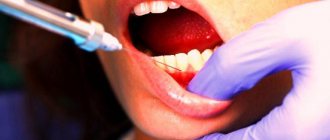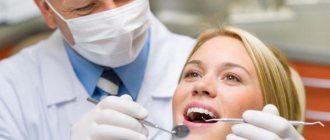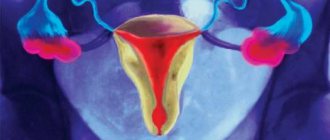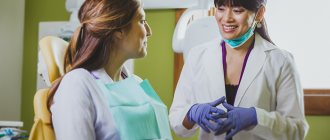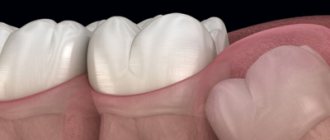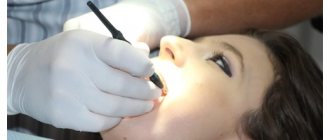- The first thing the gynecologist pays attention to during an external examination is the swelling of the genital organs. During pregnancy, due to increased blood circulation, the labia minora and majora lose their elasticity and become dense.
- The second sign of pregnancy is a change in the color of the internal genital organs. The vaginal walls take on a dark red or purple hue. The mucus released from the cervical canal becomes viscous and transparent.
- Then the doctor examines the cervix, appendages - fallopian or fallopian tubes, ovaries. During pregnancy, these organs enlarge and change their shape, so by palpation (manual examination) pregnancy is easy to determine.
- Next, the condition of the posterior vaginal vault is checked. Before pregnancy, the posterior vaginal vault has the shape of a retracted vault, and with the onset of pregnancy it becomes smooth.
Even during pregnancy, changes occur in a woman’s mammary glands.
Under the influence of hormones, the breasts begin to prepare for lactation (the process of feeding a child), more milk ducts are formed in it and the breasts increase in size. You should know that during an examination, a gynecologist can determine pregnancy, which is at least the fifth week, and to determine the onset of pregnancy earlier, an ultrasound examination (ultrasound) should be performed.
Why is it not recommended to undergo cosmetic procedures during pregnancy?
Women who regularly resort to the injection of hyaluronic acid, fillers, Botox, and laser procedures find it difficult to understand why they should be abandoned during pregnancy and breastfeeding.
The fact is that some of the hormonal and physical changes that occur in the skin and body during this period can cause complications. Therefore, experts recommend temporarily abandoning them.
In addition, it is not known whether injected drugs can cross the placenta and pass into breast milk. Large-scale scientific studies on this issue have not yet been carried out, and most likely they will never be carried out. The reason is the ethical difficulties associated with clinical trials involving pregnant and breastfeeding women.
According to Nina Naidoo, MD, many medications and procedures that may be safe for pregnant women simply cannot be recommended due to a lack of data on their safety for mother and baby.
This is why pregnancy is considered a contraindication to many cosmetic procedures due to possible unexplained complications.
Pregnant woman
The body of a pregnant woman continues to actively prepare for the birth of a baby, the content of estrogen rapidly increases, and the level of progesterone decreases significantly. Changes in hormonal levels help soften the tissues of the birth canal and cervix. Throughout pregnancy, the lumen of the cervical canal is closed by a plug of thick mucus, which protects the baby from infection, and the uterine cavity protects against the penetration of microorganisms hazardous to health. In the last weeks of pregnancy, the consistency of the mucus changes, it becomes more liquid and begins to gradually flow out. In some women, the mucus disappears gradually, while in other women in labor it comes off simultaneously. The discharge resembles colorless egg white in its consistency and appearance. Sometimes the mucus is pinkish, brown or yellow. The removal of the plug is painless; the woman may experience a slight feeling of discomfort in the lower abdomen. The removal of the plug may be signaled by more abundant vaginal discharge than during the entire pregnancy.
A woman should carefully monitor the color and volume of discharge, since too much colorless discharge may indicate not only the passage of the plug, but also be one of the symptoms of leakage of amniotic fluid. Indicator pads and amniotests or test strips will help determine the cause of the discharge. The pads are sold in many pharmacies and can be easily used at home. If leakage of amniotic fluid is confirmed, you should immediately consult a doctor.
After the mucus plug comes off, you should avoid visiting the pool and swimming in open water, as the risk of infection for the child increases significantly. It is also necessary to exclude sexual contact.
Why is it not advisable to get Botox injections during pregnancy and breastfeeding?
As Dr. Naidu explained, there have been no clinical trials examining the effects of the botulinum toxin found in Botox, Dysport, Juvo and Xeomin on pregnant women. Despite this, anecdotal evidence and clinical practice have led many experts to conclude that Botox and similar drugs administered during pregnancy will not cause harm.
Botox injections
One study showed that the botulinum toxin molecule is so heavy that it is extremely difficult for it to penetrate the placenta. In theory, it should be safe to use during pregnancy. But due to the lack of confirmed data on the absence of complications, it is better not to take risks.
Another New York-based scientist, Dr. Morgan Rabach, said he would never administer drugs like Botox to breastfeeding mothers because it is unknown whether they pass into milk. This is why such beauty injections are not given during lactation.
Effect of pregnancy on kidney function
Renal blood flow increases and glomerular filtration increases (maximum in mid-pregnancy) - associated with the excretion of metabolic products of the woman and the fetus.
The permeability of the kidneys to protein and carbohydrates increases: proteinuria (protein in the urine), glucosuria. The excretion of 140 mg/day of glucose in the urine is considered the upper limit of the physiological norm. Peak glucose secretion was detected at 9 months of pregnancy.
The peristaltic function of the ureters is sharply suppressed, as a result of which they expand and urine is retained in them. Atony of the ureters leads to impaired drainage of urine from the pelvis, which creates favorable conditions for the development of pyelonephritis in pregnant women. In the postpartum period, these phenomena soon disappear.
Is it possible to enlarge lips during pregnancy?
Many girls got used to constant filler injections before pregnancy, and decide to inject them again during pregnancy. Fillers act locally and should not pass into breast milk or cross the placental barrier, but due to the lack of confirmed scientific data on the safety of such a procedure, it is not recommended.
- Due to hormonal fluctuations and swelling, lips can change shape during pregnancy. As a result, after childbirth, when appearance returns to normal, they will look unaesthetic. Asymmetry may even appear.
- An altered metabolism can lead to the fact that the fillers will dissolve in a month or two, and the procedure will simply be useless.
Therefore, lip augmentation during this period is not worth it due to medical contraindications and the unpredictability of the result.
The structure of the external (and internal) genital organs changes
- The external genitalia become swollen and hyperemic. Cyanosis of the mucous membranes of the vaginal part of the cervix, vagina and its vestibule occurs, which indicates vasodilatation and blood stasis, facilitating serous permeation of the tissues necessary for the deposition of nutrients at the site of attachment of the fertilized egg to the uterine wall.
- The vagina expands and lengthens somewhat during pregnancy. The walls of the vagina are swollen and thickened. The discharge becomes more abundant, mucous in nature, milky white or yellowish in color with an acidic reaction. In a healthy pregnant woman, the vagina has I-II degrees of cleanliness.
The uterus changes the most during pregnancy compared to other organs.
Its size increases during pregnancy in all respects:
- weight - from 50-100 g to 1-2 kg!!!
- length - from 7-9 cm to 50 cm,
- volume - 500 times, reaching 2-3,000 cm3 (liters) or more.
Accordingly, changes occur in all tissues, blood supply and innervation of the uterus:
- The shape and position of the uterus changes during pregnancy. As the uterus grows, it emerges from the pelvis into the abdominal cavity, rising in the 9th month of pregnancy to the xiphoid process. The shape of the uterus is asymmetrical due to the bulging of the part where the placenta is attached.
- Thin arteries and veins of the uterus turn into powerful trunks, which become corkscrew-shaped, tortuous, which allows maintaining normal blood supply during pronounced changes in the uterus during pregnancy and during contraction of its muscles during childbirth.
- The volume of blood circulation in the uterus during pregnancy increases tens of times, providing uteroplacental blood flow, which is carried out according to the principle of blood supply to vital organs and remains relatively optimal even under various stresses (blood loss, anemia). This ensures the survival of the fetus in extreme situations.
- The receptor system of the uterus changes: during pregnancy, the sensitivity of the uterus to stimulating factors decreases, before childbirth, the excitability of the uterus increases, some of the nervous structures are lost in order to reduce pain information from the uterus during childbirth.
With the appearance of the placenta, a pregnancy dominant arises in the cerebral cortex, which ensures clear coordination of the functions of all organs and systems in the interests of the developing fetus.
Women note a decrease in performance, increased drowsiness, or vice versa, they are irritated, they have nausea, drooling, periodic vomiting, which is classified as mild and the occurrence of which corresponds to the phase of functional changes in the nervous system.
Pregnant women have increased suggestibility and self-hypnosis, which is taken into account when conducting psychoprophylactic preparation for childbirth.
Phenomena of paresthesia, neuralgic pain, spasms of muscle groups, numbness of the fingers and other disorders may occur. Increased excitability of peripheral nerves is also manifested by increased knee reflexes.
With all this, sexual excitability decreases , and you, dear husbands, must be prepared for this. No need, under no circumstances!!! (remember about increased suggestibility and self-hypnosis) do not show your grievances that your wife is cold and inattentive to you, which means she has stopped loving you. She still loves you, she is already carrying your child and she has a dominant in her cerebral cortex - to endure pregnancy at all costs. And there is no escape from this.
- In a pregnant woman, the functions of some analyzers change - hearing, vision, smell!!! A pregnant woman's sense of smell can become so strong that the woman will react to the lightest (hardly perceptible) odors.
Please keep in mind, dear men, when a woman feels bad, feels sick, and the world is generally in shades of grey, for some reason unhappy thoughts come into her head, which can lead to a deterioration in her condition and, as a consequence, to termination of pregnancy.
During pregnancy, changes affect other organs as well.
The adrenal glands increase in size during pregnancy due to cortical hyperplasia, and the glucocorticoid and mineralocorticoid function of the adrenal glands increases accordingly.
Strengthening the function of the adrenal cortex during pregnancy is aimed at increasing protective and adaptive mechanisms, including during childbirth.
The thyroid gland increases in volume and function increases. Goiter in pregnant women is observed, especially in areas endemic for goiter (little iodine in soil and water) and hyperthyroidism without thyrotoxicosis. Strengthening the function of the thyroid gland is associated with the influence of placental hormones on it. Clinical thyrotoxicosis does not develop due to increased binding of free hormones by plasma proteins. The protein-bound form of the hormone is subsequently utilized by the fetus and the mother’s body, since the need for it increases with the development of pregnancy, before the onset of fetal thyroid function.
The parathyroid glands (calcium metabolism) undergo hypertrophy, their functional activity increases due to the increased need for calcium, which is a plastic material for the formation of the musculoskeletal system of the fetus. If there is insufficient intake or impaired absorption, the fetus receives calcium from the tissues of the mother’s body (bones, teeth), which can manifest itself as osteoporosis, fragility and dental caries. During pregnancy, the concentration of calcium in the blood increases. The content of phosphorus compounds, iron and a number of microelements (cobalt, iodine, manganese, copper) also decreases in the blood plasma. The deficiency of these substances is due to the needs of the fetus and increased metabolic reactions, the enzyme systems of which include some of the micro- and macroelements.
Pancreas – strengthening the function of the insulin-producing apparatus. As a result, carbohydrates are absorbed very well and are deposited in the mother’s liver and in the tissues of the fetus. Women with diabetes always give birth to large children due to the utilization of excess carbohydrates by the fetus. Some pregnant women experience glucosuria (sugar in the urine), which is not pathological and manifests itself with normal or even low carbohydrate levels in the blood.
The pituitary gland in pregnant women increases in volume and is difficult to fit in the sella turcica; hyperproduction of growth hormone (GH) is observed, which, penetrating the placenta, stimulates the growth of the embryo. This hormone also affects the lactogenic function of the mammary gland, causing in some cases an enlargement of the nose, lips, and fingers.
How can this affect the child? Can his mother infect him with the virus in the womb?
The impact of COVID on the fetus during pregnancy is not completely known. To date, there is no data that would confirm the fact of intrauterine infection (penetration of the virus to the fetus) or intrauterine infection (development of symptoms in the fetus). However, there is no reverse data that would reliably exclude the possibility of vertical transmission of the virus. Coronavirus during pregnancy before childbirth can be dangerous because an infected mother can infect the child immediately after birth. This happens through the traditional airborne or household contact route.
Should you postpone pregnancy?
There are quite a lot of “blank spots” in the answer to the question of how COVID affects pregnancy in the immediate and long-term period after infection. However, clinical recommendations state that after an illness, conception should be postponed for at least 3 months. This duration of the time pause is explained by 2 arguments. On the one hand, in the 3-month period after an acute infection, there is a possibility of developing delayed complications, especially for thrombosis of various locations. On the other hand, 3 months are necessary for the complete elimination of pharmacological drugs used to treat the infection. Their negative impact can be much more serious than the direct consequences of COVID on pregnancy.
The average spermatogenesis cycle lasts 3 months. In other words, during this time, renewed sperm mature, which do not contain toxic substances formed during the metabolism of pharmaceuticals. In women, the period of folliculogenesis (the complete cycle of egg maturation) is shorter. Therefore, doctors advise focusing on a larger gap, that is, on the male factor.
We answer popular questions
The COVID-19 pandemic, announced by WHO in March 2022, has made serious adjustments to the life of modern society. News reports are full of figures about the number of people infected, recovered and those who could not cope with the disease. The infection itself and its complications can cause serious harm to the adult body. What will happen to the fetus, does COVID affect pregnancy, how to protect yourself? These and not only these questions are often asked by young couples who are just planning to become parents or are already waiting for a miracle. Let's talk to the experts at the SM-Clinic Reproductive Health Center about how to behave correctly.
Where is Botox injected?
Botox injections are performed using ultra-thin needles, which avoids trauma to the skin and unsightly specific marks. The drug, as already mentioned, is injected into the area of localization of pronounced facial wrinkles.
- Forehead. Most often, injections are made in the frontal area, since Botox is effective in combating vertical wrinkles between the eyebrows, as well as smoothing deep horizontal frontal furrows;
- Eyes and lips. The introduction of Botox into the periorbital and perioral plane of the face will eliminate small expression wrinkles in the corners of the eyes and lips, which are popularly called “crow’s feet”;
- Neck area. Botulinum toxin therapy for the neck is rarely used, but with sufficient qualifications of the doctor, it can maximally correct age-related changes in the neck muscles;
- Nose. So-called “anger lines” on the bridge of the nose can also be corrected with botulinum injections.
Much less often, beauty injections are used to correct facial wrinkles in the lower third of the face, since in this case there is a risk of drooping (sagging) of the muscles that hold the facial contour. That is why the qualifications of the specialist who carries out this procedure are very important here.
Such injections do not cause discomfort to the patient himself, due to the fact that the skin is pre-treated with a local anesthetic solution. In the technique of botulinum injections, it is very important that the specialist correctly determines the area of injection of the drug, since the effectiveness of the procedure will ultimately depend on this factor. In order to eliminate the possibility of error, the doctor may ask the patient to grimace and twist during the procedure in order to determine the area where the largest number of facial folds of skin accumulate.
Detection of cervical diseases
To determine the presence or absence of pathological changes, the doctor conducts a screening examination of the cervix, including:
- cytological examination - analysis of particles of the epithelium of the cervix and cervical canal for the presence of atypical cells, including cancer cells;
- microflora smear - analysis of vaginal or cervical mucus for the ratio of beneficial, opportunistic and pathogenic microorganisms, indicating the general condition of the body, the reproductive system, the presence or absence of inflammatory diseases;
- smear for infection - examination of the mucous discharge from the vagina for the presence of clearly pathogenic microorganisms (viruses, bacteria, fungi, protozoa), indicating the presence of an infectious process in the genital tract.
Also, as part of a screening study, hystroscopy may be prescribed - a visual examination of the cervix using a thin and flexible instrument equipped with a camera or optical system (hystroscope). It is inserted directly into the vagina and cervical canal, allows you to evaluate the color and thickness of their mucous membranes, determine the presence of polyps and other neoplasms, the size of the cervical lumen, etc.
The combination of these methods gives doctors the opportunity to determine the general condition of a woman’s body and her reproductive system, and promptly identify possible pathologies and complications. This increases the likelihood of their successful treatment, including gentle conservative methods.
How does Botox work after injection?
Botox is a cosmetic drug that contains weakened botulinum toxin. This substance is produced during the life of the bacterium Clostridium botulinum. Scientists have learned to use the special properties of botulinum toxin in cosmetology practice, with the goal of radical rejuvenation of the face and neck.
Botox is administered through subcutaneous injections into the area where expression lines are concentrated - the most unpleasant primary sign of aging. Penetrating into the fibers of the facial muscle, botulinum toxin blocks the mechanism of neuromuscular transmission, causing inhibition of a particular muscular structure of the face. Why is this necessary? Unlike other muscles, the facial muscles are in close contact with the skin, ensuring its tension. When a muscle is exposed to a toxin, it completely relaxes, which leads to the smoothing of the skin attached to it. Visually, this is manifested by the complete smoothing of facial wrinkles and skin creases of varying depths, which transforms and rejuvenates the patient’s face.
As a result of such a radical effect, a person loses the ability to control the muscle. However, contrary to popular belief, the face does not look like an artificial mask at all, which is due to the selective technique of administering the drug. Simply put, the static nature of one individual muscle is completely unnoticeable against the background of active facial movements of the surrounding facial muscles. This is why Botox injections can only be done in a good clinic. Only an experienced cosmetologist will accurately select the area of injection of the drug to achieve the desired result. The doctor performing botulinum therapy must undergo special training and have good experience, otherwise the result may be disastrous.
Speaking about the mechanism of action of Botox after administration, one cannot fail to note the fact that botulinum toxin has temporary activity. In the process of metabolism and enzymatic reactions, the toxin is gradually eliminated from the body, weakening the effect on the muscles and returning the former facial expressions. This can be considered both a positive feature, because the patient does not have to worry about the irreversibility of the effect, and a negative one, due to the need to re-administer the drug to maintain the anti-aging effect.
Immediately after the procedure
In fact, the entire healing procedure can be divided into several stages. Initially, swelling appears. Then hematomas may occur. This reaction is considered normal. Additionally, there may be a feeling of tightness and fullness in the mouth area.
You should not evaluate the result immediately after the procedure. It will change somewhat in the future. To understand what your lips will look like, you need to wait a few days. In general, the result is visible within a week.
If bruises appear, there is also no need to panic. They occur if the cosmetologist touches a vessel. The situation is not dangerous. However, this may not look aesthetically pleasing. They will go away on their own within a few days.
On the first day after the procedure, you should not drink hot drinks. It is better to minimize the use of cosmetics. Additionally, you should not swim in the pool or overheat. If you follow your doctor's recommendations, the likelihood of developing side effects is minimal.
Is Botox harmful to health?
The question regarding the harms and benefits of Botox remains one of the most pressing for patients who have decided to undergo botulinum rejuvenation. The mechanism of action of the drug frankly frightens the majority of patients, who most often, as practice shows, fear paralytic effects on the surrounding muscles, distortions and drooping of facial muscles and other aesthetic problems. There is absolutely no need to worry about this, since the composition of botulinum preparations is absolutely safe and does not cause complications or side effects.
Such fears fuel unreliable Internet stories and myths about Botox, which, despite the drug being studied, continue to be passed on, as they say, “from generation to generation.” In fact, according to statistics, aesthetic harm from Botox occurs in only 0.14% of patients and is caused only by violations of the drug administration technique. Possible complications also include the following conditions:
- pain in the injection area occurs in 1.3% of patients;
- no more than 2% of people experience mild headaches;
- small hematomas at the injection site occur in 6% of patients only due to the fault of the specialist;
- temporary loss of sensitivity in the injection area is observed in less than 1% of cosmetologist’s clients;
- About 1% of the population is allergic to the drug;
- Infectious contamination of the injection site is extremely rare and is a consequence of non-compliance with the requirements of asepsis and antisepsis during the procedure.
All complications are exclusively temporary and disappear as botulinum toxin is removed from the patient’s body. When discussing unsuccessful botulinum therapy procedures, one cannot help but note that there is a small percentage of people (1-2%) who are resistant to the effects of this toxin and the procedure in this case does not allow achieving a rejuvenating effect.
When does Botox start to work after injections?
Many patients, before this cosmetic procedure, are concerned about the question of how long it takes for Botox to work after introducing the drug under the skin. This topic is relevant for those clients of a cosmetologist who are sure that they can leave the clinic only when the effect of Botox appears. In fact, there is no immediate blockade of the neuromuscular motor impulse after administration of the drug. Typically, noticeable results gradually increase over 3-5 days after injections.
Today, the cosmetology market also offers a popular analogue of Botox – the French drug Dysport, which exhibits a pronounced effect already on the first day after the procedure.
At the same time, when Botox begins to act, it is not at all necessary to remain under the supervision of a doctor, since the effect can be gradually adjusted over three months, after the first use of botulinum therapy, and the most expressive final result can be achieved only after 2 weeks. After this period, it is recommended to undergo an examination with your cosmetologist. The doctor will evaluate the result and, if necessary, “fill in” the missing dose of the drug. Thus, your cosmetologist accurately selects your dose of Botox. It depends how long it takes for Botox to start working, primarily on the individual characteristics of the patient’s metabolism.
Recommendations after lip augmentation
When the procedure is completed, the main period of care begins. Initially, severe redness and swelling may appear. The process is considered natural. Over time, such phenomena disappear.
Injection marks may also be visible. They are especially pronounced in the first two days. Then the swelling and inflammation go away. Lips acquire the desired shape.
There is no need for long-term rehabilitation after lip augmentation using injections. However, it is necessary to understand that the sensitivity of the skin in the affected area will increase. Therefore, it is highly recommended not to touch or rub it in the first few days. Additionally, massage is prohibited. If the patient is hypersensitive, an anesthetic ointment can be used. The doctor will prescribe a suitable drug.
You can massage the lip area only 4 weeks after the injections, unless the cosmetologist says otherwise. In this case, exposure is permissible only after the swelling has subsided. To speed up healing, you can use Panthenol. Additionally, the following recommendations must be observed:
- during the first week it is better not to use decorative cosmetics;
- you must stop drinking alcohol;
- on the first day, the consumption of hot foods is prohibited;
- until the lips have healed, it is better not to smoke;
- During the recovery period, you cannot do permanent makeup or use peeling.
Excessive physical activity is prohibited. They can be resumed after 7 days if the patient feels well. Despite the fact that the lips themselves are not involved during physical activity, the temperature rises. This can slow down the healing process. Additionally, sunbathing and tanning in a solarium are prohibited. Sauna and steaming procedures are generally prohibited. It is better not to swim in the pool or sea temporarily, as this can lead to allergies or irritation, as well as infections.
Early stage therapy
To diagnose the disease at the initial stage, you need to pay attention to suspicious symptoms and contact a gynecologist as soon as possible. At the appointment, the specialist will conduct a gynecological examination of the internal and external genital organs, identifying swelling of the posterior or middle part of the labia, which displaces the vestibule of the vagina to the side. To confirm the diagnosis, additional diagnostics are carried out, including the following procedures:
- Laboratory examination of gland secretion. This diagnostic method will help identify the infectious pathogen that provoked inflammation of the Bartholin glands.
- Analysis of a vaginal smear to determine the nature of the microflora.
- Bartholinitis during pregnancy responds well to conservative treatment, but provided that the disease is not advanced and a purulent capsule has not yet formed. To stop the inflammatory process, applications with the Miramistin bactericidal solution are used. Decoctions of chamomile, calendula, oak bark, and sage are well suited for washing.
The following medications may be prescribed:
- "Polygynax". It has a bactericidal, fungicidal and anti-inflammatory effect. It is used in the form of suppositories according to the scheme: 1 suppository at night. The drug is safe for children.
- "Levomekol". Antibacterial ointment characterized by a pronounced antiseptic effect. It is used in the form of applications to the area of the inflamed gland.
- Vishnevsky ointment. The effect of use is the same as that of Levomekol. Used in the form of lotions.
Which Botox is better to inject?
The modern cosmetology market offers several drugs that contain botulinum toxin type A. The most popular, in addition to the world-famous American Botox, can also be considered the French drug Dysport. The main differences between these products are the dosage of botulinum toxin, as well as the speed of formation and duration of the final effect. An experienced cosmetologist will help you choose the most suitable drug for yourself, but most experts recommend giving preference to the classic American Botox from the Allergen company, due to the greater knowledge of this product.
How can a pregnant woman protect herself during COVID?
During pregnancy, even if you have been vaccinated against COVID in advance, you should follow sanitary rules that will help reduce the risk of infection:
- maintain a distance of at least 1.5 meters;
- wash your hands or use sanitizer;
- do not touch your eyes, mouth and nose with unwashed (untreated) hands;
- ventilate the premises;
- avoid crowded places.
When the first suspicious symptoms of a new coronavirus infection appear, you should immediately contact a medical facility. It is easier to prevent complications than to eliminate them later.
Antibacterial therapy
If the disease is advanced and cannot be treated sparingly with the use of bactericidal ointments and solutions, then the doctor decides to use antibacterial drugs. The treatment regimen is determined individually, taking into account the duration of pregnancy, the stage of progression of bartholinitis, the presence of associated complications, and the type of pathogen that provoked the inflammation.
To destroy a bacterial infection, the following drugs are often prescribed:
- "Amoxiclav";
- "Augumentin".
The course of therapy and dosage are individual. Also safe for the fetus are drugs belonging to the group of cephalosporins:
- "Ceftriaxone" in the form of injections;
- "Cefexin" for oral administration.
If inflammation of the Bartholin glands occurs with complications, the pregnant woman is prescribed the antibiotic Sumamed. The course of therapy is carried out under the strict supervision of a specialist. The doctor monitors the condition of the unborn child, as well as the effectiveness of the drug used, and adjusts the regimen if necessary.
How long does the effect of Botox last?
How effective Botox is is perhaps one of the most frequently asked questions. Here it should be understood that there simply cannot be an unambiguous answer to this question, since the duration of local muscle relaxation will, like the speed of achieving the effect, directly depend on the metabolic functions of the body, more simply, on the metabolic rate. However, experts say that after the first administration of the drug, the average duration of action of Botox will be from 4 to 6 months.
Also, speaking about the duration of action of Botox, it is simply impossible not to mention the increased effectiveness of the drug with repeated administration. Repeated injections show a significantly longer lasting effect, which can range from 8 to 12 months. In addition, regular use of botulinum therapy often gives the cosmetologist the opportunity to reduce the dosage. This is largely explained by the fact that being stationary for a long time, the facial muscle loses the “habit” of actively moving, and a person loses the habit of “frowning,” which reduces the load on the facial muscles and the severity of wrinkles.
At what age can Botox be injected?
Manufacturers do not indicate clear restrictions on the age group, however, most specialists do not work with patients under 18 years of age. Moreover, at such a young age, there are most often no clear indications for such radical anti-aging therapy. The only exceptions are individuals who have a genetic predisposition to the formation of facial wrinkles. Many people mistakenly believe that this phenomenon is associated with overly active facial expressions, but in fact this factor is of secondary importance, after heredity.
When answering the classic question, at what age can Botox be injected, most experts still determine the age group from 30 to 45 years, when the drug will demonstrate the most pronounced effectiveness. At the same time, for elderly patients over 60 years of age, the relevance of Botox is lost every year, due to the manifestations of age-related tissue ptosis, which is noticeable even when the muscle is in a relaxed state.
Signs of varicose veins
Most often, it all starts with visual manifestations. Spider veins and reticular veins appear. Then there are clinical symptoms: swelling of the lower extremities at the end of the working day, heaviness, fatigue, a feeling as if the legs are on fire. Some patients experience a condition called restless legs syndrome.
In more advanced stages, skin changes (redness, thickening, soreness) may be observed along the course of varicose veins. This condition is characterized as thrombophlebitis. Trophic changes in the skin and the formation of trophic ulcers on the affected lower limb may also occur.
Symptoms and complaints of perineal varicose veins
In the classic version, there is a triad of symptoms:
- Pelvic pain.
- Varicose veins of the labia and perineum.
- Dysmenorrhea is a cyclical process, when during menstruation severe pain in the lower abdomen, heavy menstrual bleeding, and menstrual irregularities may appear.
- With a long course of the disease, the development of dyspareunia is possible - painful sensations in the lower abdomen that occur during or after sexual intercourse. A peculiarity of this symptom is the persistence of pain for at least 30 minutes and up to a day after sexual intercourse.
